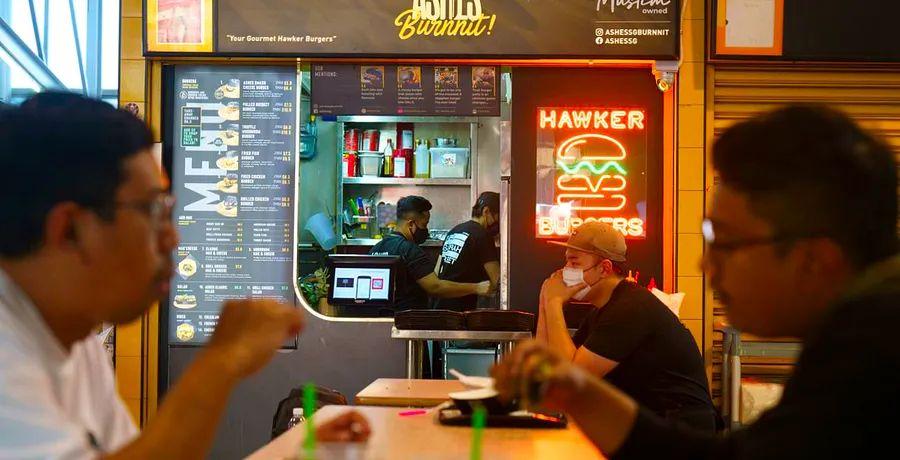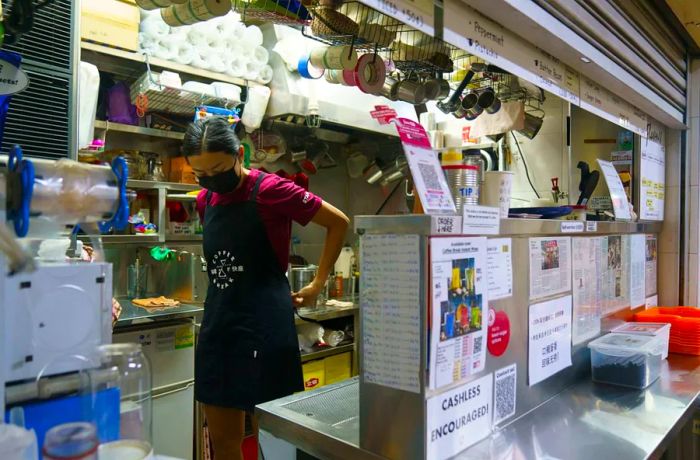The Ups and Downs of Singapore's New Hawkerpreneurs

Faye Sai and her siblings spent their childhood working in their father's small coffee shop, or kopitiam, just as he had done in his father's kopitiam years earlier. Located in one of Singapore's renowned hawker centers, the stall was cramped and sweltering, even for children. Sai recalls the grueling days, long hours, and constant complaints. Yet, none of this deterred her from following her father's legacy and becoming a hawker herself.
Since taking over her father's stall, Coffee Break, in 2011 at the bustling Amoy Street Food Centre, Sai and her siblings have been serving the same traditional Nanyang kopi made from dark robusta beans. However, under Sai's guidance, Coffee Break now also features trendy flavored lattes like salted caramel, black sesame, and pistachio. Unlike older kopitiams that serve takeaway drinks in clear plastic bags, Coffee Break provides customers with disposable cups, similar to those found at Starbucks.
Sai represents a new wave of hawkerpreneurs, ambitious young Singaporeans leveraging the country's traditional hawker centers for a fresh approach to food business. While these vibrant new ventures are drawing essential foot traffic to Singapore's struggling hawker centers, some critics argue that their menus stray too far from authentic Singaporean cuisine, jeopardizing vital aspects of the nation's culinary heritage.
For years, Singaporeans have expressed concern that there aren’t enough young people willing to pursue hawker work to ensure the survival of these historic centers. More than just food courts, these centers are sanctuaries of Singaporean cuisine, serving dishes like bak kut teh (herbal pork rib soup) and flame-grilled satays alongside saucy chili crab and thin wonton noodles. Without these centers — and with strict regulations preventing street vendors from operating outside — there would be nowhere for this beloved food to go, at least at prices that Singaporeans can afford.
 Faye Sai is the third generation of her family to operate a kopitiam.
Faye Sai is the third generation of her family to operate a kopitiam. Sai incorporates modern coffee flavors and stylish packaging to distinguish her shop.
Sai incorporates modern coffee flavors and stylish packaging to distinguish her shop.“For many, hawker centers serve as a convenient kitchen for local apartment residents,” explains Leslie Tay, a family doctor and culinary advocate who is also part of the government’s Workgroup on Sustaining the Hawker Trade. “That’s why many Singaporeans don’t cook — affordable food is just downstairs.”
At its finest, the hawker center embodies the values of the young nation-state: multiculturalism, a shared heritage, and a communal village spirit. However, it’s also a tough life, and few long-time hawkers express a desire for their children to follow in their footsteps. Jasmine, a 62-year-old hawker who has been serving Hainanese chicken rice and roast meats for over 40 years, states, “I wouldn’t want my own nephew and niece to continue this.” In her view, “[It’s] better for them to pursue education and find easier work.”
Thanks to the nation’s booming economy, that kind of “easier” life has become a reality for an increasing number of young Singaporeans, who are choosing to climb the socioeconomic ladder rather than endure the demanding hawker trade, traditionally linked with hard work, low wages, and low social standing. “Generally, hawker work is perceived as blue-collar,” notes Tay. “It’s not that young people are unwilling to become hawkers; they simply don’t aspire to it as a career.”
Tay’s initiatives are part of a broader government effort to reshape this perception, encouraging young individuals to consider hawker careers by providing grants for kitchen equipment and promoting a sense of community through conferences and events. However, this approach has its downsides: the emergence of new hawkers introduces fresh concepts, unconventional foods, and a focus on branding that some fear may divert customers from traditional stalls.
 Ashes Burnnit is one of the modern hawker stalls located in one of Singapore’s traditional centers.
Ashes Burnnit is one of the modern hawker stalls located in one of Singapore’s traditional centers.Not everyone shares that perspective, particularly the hawkerpreneurs. Lee Syafiq, 28, ventured into hawker life four years ago. He trained as a professional chef and worked in hotels and fine dining establishments, but when he aimed to launch his own venture, a gourmet burger stall named Ashes Burnnit, he opted for an open stall within a local hawker center.
“One reason I chose to become a hawker is that the startup costs are significantly lower than opening a restaurant or café,” Syafiq explains.
He ultimately envisions franchising the concept and transforming Ashes Burnnit into a nationwide chain.
“People often mention fast-food giants like McDonald’s, KFC, and Burger King,” he notes. “We aspire to be a household name as well, but we want to begin in a Singaporean hawker center. Launching in a hawker stall as part of the new generation? That carries weight and tells a story.”
On the menu at Ashes Burnnit, you’ll find items like smashed cheeseburgers and pulled brisket. It’s a significant departure from the typical bak kut teh and fish-head curries available a few stalls away, but for Syafiq, that’s precisely the idea.
“In our case, we want to demonstrate something,” Syafiq states. “Hawker culture is evolving, and so is the food. More people are entering the scene, and hawker centers can offer more than just traditional dishes.”
Not surprisingly, there has been resistance. Early on, several veteran hawkers voiced concerns about Syafiq’s franchise model, fearing that quality might suffer with expansion. Sai has faced similar pushback. Some patrons criticize the shop for focusing on what they view as cheap gimmicks and novelty items rather than authentic cups of kopi. There’s a prevailing belief that young hawkers should respect the traditions established by their predecessors.
However, Sai contends that innovation doesn’t inherently clash with the essence of hawker culture. “It was really my father who emphasized the need for us to innovate and lead trends,” Sai explains, noting that he had started experimenting with almond- and hazelnut-flavored kopis long before she and her siblings took charge.
Other traditional hawkers are not immune to trends either. In 2017, during Singapore’s national obsession with salted egg, many older vendors began draping classic dishes in the salty-sweet sauce. Even the beloved Singaporean carrot cake, typically covered in a rich dark sauce, was given the salted-egg treatment, and you can still find salted-egg variations on the menus of classic stalls today.
“They assume we’re young and new, thinking this hasn’t been done before,” Sai remarks, “but if you look back 15, 20, or even 30 years, it’s quite similar.”
 The signature burgers offered at Ashes Burnnit
The signature burgers offered at Ashes Burnnit Founder Lee Syafiq aspires to expand his burger stall into a nationwide chain.
Founder Lee Syafiq aspires to expand his burger stall into a nationwide chain.Preserving traditional food practices amidst rapid globalization is a complex challenge. Singapore, a relatively young nation-state, has become a center for international trade, commerce, and the exchange of ideas, constantly influenced by powerful foreign trends — from K-pop to Western media. In this context, food emerges as a cultural anchor that even many hawkerpreneurs are keen to safeguard.
“Growing up in a hawker center when my grandfather opened a kopitiam in our neighborhood was a joy — the sights, the smells, the food, and the community,” Sai recalls. “For me, that’s what heritage means.”
Lee Syafiq is now involved in the newly launched Hawkers’ Development Program, a concept proposed by Tay, and he has already taken on an apprentice. The trainee works at Syafiq's stall, learning the trade, while Syafiq provides feedback on his menu and techniques. Syafiq hopes that his apprentice will one day establish his own stall and mentor aspiring young hawkers as well.
“To me, the notion that a small business can attract 200 or 300 customers daily while maintaining long-term sustainability — that is the essence of hawker culture,” he expresses.
Jacklin Kwan was born and raised in Singapore and now lives in Manchester, UK, where she is pursuing a career in journalism. Huiying Ore is a Singaporean documentary photographer focused on capturing the stories of communities and places in Southeast Asia affected by development.

1

2

3

4

5
Evaluation :
5/5